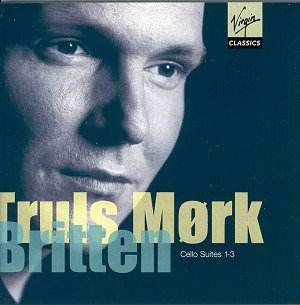Truls Mørk adds to his already impressive discography
with this recording of the three Britten Cello Suites. His recording
of the Britten Cello Symphony (with the Elgar Concerto on VC5
45356-2, accompanied by the City of Birmingham Symphony Orchestra
under Rattle) was an impressive achievement, and he showed his affinity
with Shostakovich in the disc of the two cello concertos (LPO/Mariss
Jansons) on VC5
45145-2.
The Solo Cello Suites were originally written for the
composer’s close friend Mstislav Rostropovich and there are recordings
of Nos. 1 and 2 by this great musician on London 432
859-2 (he actually never recorded the Third Suite). They were written
in 1964, 1967 and 1971 respectively. There is the inevitable resonance
of Bach in the very act of writing these works, which Britten transforms
into his own very personal musings. Indeed, Britten originally planned
six such works, but fate got the upper hand and he was unable to complete
the sequence through ill-health.
The danger is that Rostropovich’s shadow is inevitably
going to fall over all those who present these works. Not only was he
a personal friend of the composer and the dedicatee, he also happens
to be (arguably) the greatest cellist of the twentieth century. It is
a measure of Mørk's integrity of utterance that he stands his
ground, bringing his own stamp in particular to the lyrically resonant
side of these pieces. He possesses a glorious tone and displays a real
affinity with the long line.The very first movement of the First Suite
(entitled ‘Canto primo: Sostenuto e largamente’) shows this perfectly:
but he also seems to revel in the more experimental musical language
fourth movement (‘Marcia’) and the virtuoso challenges of the final
Moto perpetuo. Amazingly, all the fast detail in the lower register
in this finale seems to come through clearly, a tribute not only to
Mørk’s fine articulation and clarity but also to the excellence
of Arne Akselberg’s recording.
The Second Suite demonstrates the various contrasting
sides to Mørk’s personality. The lyrical, almost wistful fugue
and the Andante lento (which in this performance brings the marking
‘dolente’ to mind as a possible addition to this direction) sandwich
between them a scherzo which brings out the cellist’s wilder side.The
final sections of the last movement (Ciaccona) are atmospherically caught,
truly dark in intent and effect.
The nine movements of the Third Suite are unified by
four Russian elements: the Kontakion (hymn for the dead) and three of
Tchaikovsky’s folk-song arrangements. Mørk is at his most expressive
in the Canto (the third movement). Only in the fifth movement, the Dialogo,
did I imagine what Rostropovich would do, and how much more jaunty he
would be.
There is no doubting the power of this music. Mørk
successfully couples a young man’s enthusiasm and a beautiful tone with
a worldly understanding beyond his years to produce a disc that will
leave few unmoved.
Reviewer
Colin Clarke

![]() Truls Mørk (cello).
Truls Mørk (cello).
![]() Virgin Classics VC5
45399-2 [DDD] [73'07] Recorded in Ris Church, Oslo, Norway on October
11th-16th, 1998 and June 6th, 2000.
Virgin Classics VC5
45399-2 [DDD] [73'07] Recorded in Ris Church, Oslo, Norway on October
11th-16th, 1998 and June 6th, 2000.